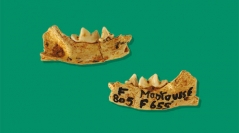

 Comptes Rendus Palevol
21 (28) - Pages 595-618
Comptes Rendus Palevol
21 (28) - Pages 595-618The palaeontological site of Montoussé (Montoussé, Hautes-Pyrénées, France) was discovered by Édouard Harlé in 1892. Montoussé Breccia 5 is dated from the Early Pleistocene (1.2-1.5 Ma). It has yielded a large number of small to medium-sized species, including a homogeneous series and important sample of small mustelids. We provide here a morphological and metrical analysis of these 52 mustelid specimens in order to provide identification keys that differentiate the weasel Mustela nivalis Linnaeus, 1766, the stoat Mustela erminea Linnaeus, 1758, and their fossil relatives Mustela praenivalis Kormos, 1934 and Mustela palerminea Pétenyi, 1864. The specific identifications are discussed in chrono-climatic context. These small carnivores are particularly sensitive to climatic variations and a correlation is established between their size and the environment. A better knowledge of inter- and intra-specific variability of these species could lead to making them valid paleoenvironmental markers. The study of variability in the fossil forms raises doubts about their specific value.
Palaeontology, osteometry, morphology, Mustela, Early Pleistocene, Montoussé